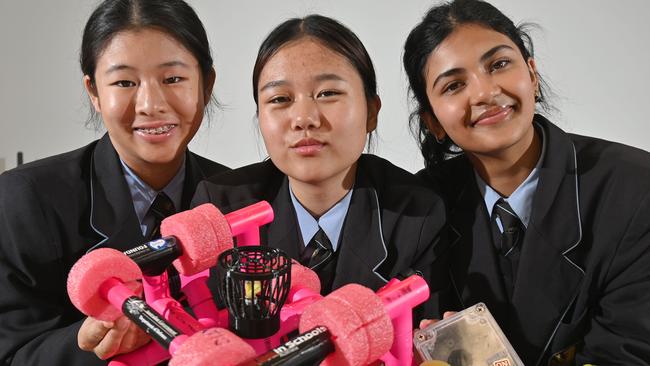Subs in Schools program engages teenage whiz kids, but uni funding scheme is failing to increase STEM graduates
Smart students around the state are learning skills needed to build nuclear submarines in high school – but a uni funding scheme designed to boost STEM numbers is failing.

SA News
Don't miss out on the headlines from SA News. Followed categories will be added to My News.
The next generation of South Australian geniuses are being cultivated in a school program aimed at developing skills to work on nuclear-powered submarines.
The Subs in Schools program is hosted across Australia for high school students as they develop working small-scale submarines in a competition that culminates in a national championship pitting teams from across the country against each other.
The program, in tandem with others including F1 in Schools and SPACE in Schools, co-ordinated by Re-Engineering Australia since 1998, is designed to introduce STEM education into schools to meet industry demand.
That’s particularly critical with a funding scheme designed to drive students to university STEM courses failing in its core target (full story below).
Wilderness School has embraced Subs in Schools with success in the state and national championships.
Year 10 students Diya Anup Kumar and Olivia Lai have been part of the successful team since last year.
And taking part in the competition has made 15-year-old Olivia consider a career in STEM.
“I didn’t really consider being an engineer as what I would like to do in the future but the competition opened my eyes to how big the industry is,” she said.

Conversations with judges at the national competition gave her an optimistic outlook with “lots of opportunities for girls in STEM” being promised.
Fellow teammate Diya, also 15, was the team leader of the project and developed management skills.
“In a team of intelligent women it was really important for me to get the best ideas out of everyone,” she said.
“Hundreds” of students both male and female participate in the program across the state as curriculum writer for Subs in Schools Stephen Read said “girls particularly love it”.
“The kids design the hull, 3D print them, trim the boat and sail the boat,” Mr Read said of the hands-on approach to the program.
“Part of it is project management, they have to produce folios, go to an engineering meeting, do a 10 minute verbal presentation and build a trade display.”
And since the AUKUS submarine project announcement, the program has been “on fire” with its uptake with hundreds of South Australian students enrolling. Industry is connected to the program with SAAB and ASC participating and judging the competition.
Students may even get a leg-up in securing a job in the future by undertaking the program.
Uni funding scheme failing the grade
By Gabriel Polychronis
A contentious university funding scheme supposed to encourage students into science and engineering fields has failed in the one objective it was designed for, sparking calls for an overhaul of the system if Australia is to have a chance of addressing concerning skill shortages.
Young Australians are still flocking to arts and humanity degrees despite the Job-ready Graduates Package dramatically increasing the student contributions required for the programs and cutting those for science and engineering courses.
The scheme is now in the federal government’s crosshairs as Education Minister Jason Clare raises major concerns with the flawed funding system.
“The motivating factor behind that scheme was to try to encourage students to study things where we’ve got skill shortages. The early evidence is that hasn’t worked,” Mr Clare told News Corp Australia.
“It hasn’t incentivised or encouraged students to shift from one course to another. And that’s really not surprising because you pick a subject based on what you love, what you’re passionate about, what you want to do.”

Universities Australia boss Catriona Jackson said Australia’s ambitious mission to build nuclear-powered submarines – requiring all workers to have some level of nuclear training – had brought the funding scheme’s failures into “stark relief”.
Ms Jackson said the model, introduced by the former Coalition government in 2020, imposed a funding cut to universities at an average of 6 per cent, with cuts of 17 per cent to maths funding and 16 per cent for science.
“Our fundamental problem is that (the package) imposes a cut which means it is harder for universities to produce those really high quality graduates, not in one or two subjects, but right across the range of subjects,” Ms Jackson said.
“Nuclear physics is really expensive to teach, just the kit, the materials you need alone often are more expensive than the entire student and Commonwealth subsidies.
“Universities are having to cross-subsidise massively to be able to teach nuclear physics, and that’s why it’s not taught in very many places, because it’s really expensive.”

Australian National University professor of higher education policy Andrew Norton said the only thing the funding model achieved was extending the time humanities students had HELP debts “hanging over them”.
“People doing humanities degrees will take forever to repay because they are borrowing a lot of money and their earnings aren’t particularly high on average, so that to me is the core problem, not that it’s going to radically change enrolment patterns for worse or for better,” he said.
Mr Clare said the Australian Universities Accord was reviewing “a range of important” issues, including the Job-ready Graduates scheme. The panel will hand down an interim report by the end of June.
Coalition education spokeswoman Sarah Henderson said the funding model “ensured students paid less for courses that were deemed a national priority”.
“The Coalition takes on board the concerns of the university sector and welcomes suggestions about how to guarantee that graduates are job-ready to work in critical industries,” she said.
More Coverage
Originally published as Subs in Schools program engages teenage whiz kids, but uni funding scheme is failing to increase STEM graduates





